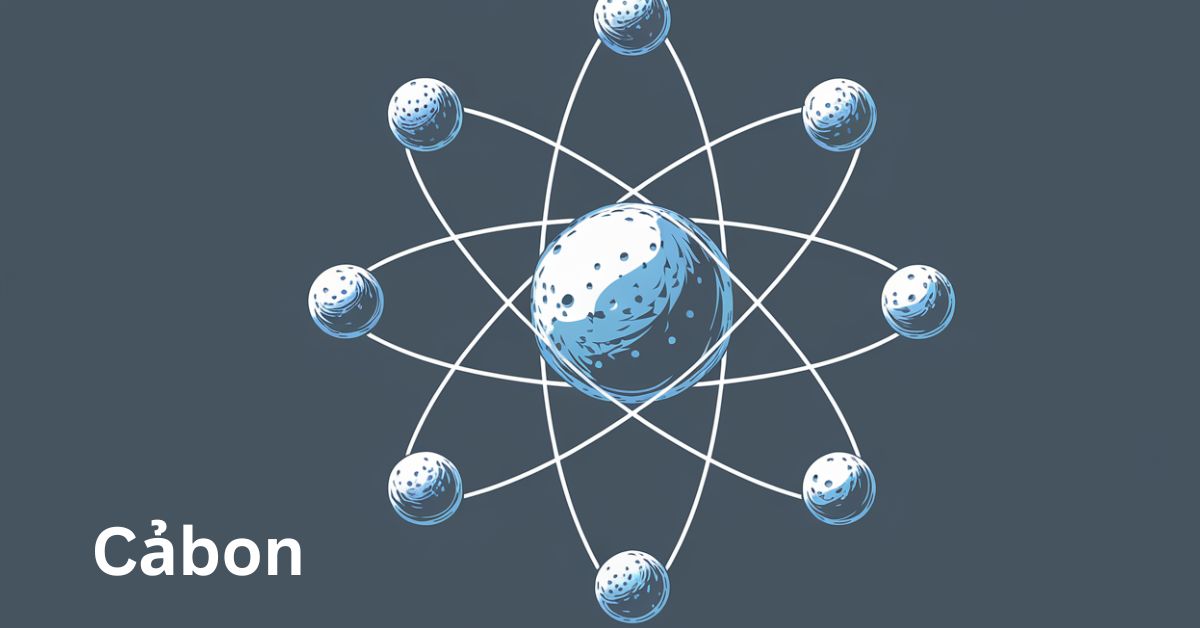Cảbon: A Deep Dive into One of Earth’s Most Essential Elements

Cảbon is one of the most fascinating elements on Earth. Despite its seemingly modest presence in nature, its importance cannot be overstated. This nonmetallic element, represented by the symbol “C” on the periodic table, is the building block of life as we know it. From the air we breathe to the food we eat, carbon is everywhere, making it a cornerstone of biological, chemical, and industrial processes. In this article, we will explore the myriad facets of carbon, or “cảbon,” diving deep into its properties, significance, and the many roles it plays in our world.
The Basics of Cảbon
Cảbon is the 14th element on the periodic table, with an atomic number of 6. It has four electrons in its outer shell, making it incredibly versatile in forming bonds with other elements. This ability to form four covalent bonds makes carbon unique, allowing it to create a vast array of compounds, from simple molecules like carbon dioxide (CO2) to complex organic molecules like DNA.
In nature, carbon exists in several forms, known as allotropes. The most well-known of these are graphite and diamond. While both are composed of pure carbon, their properties differ drastically due to their distinct atomic structures. Graphite is soft and conducts electricity, making it useful in pencils and batteries, while diamond is the hardest natural substance on Earth, prized for its brilliance and strength.
Cảbon in the Natural World
Cảbon is not particularly abundant in the Earth’s crust, making up only about 0.025% of it. However, it is incredibly widespread and is a key component of all known life forms. In the biosphere, carbon is the backbone of organic chemistry. All living organisms contain carbon; it forms the basis of proteins, carbohydrates, fats, and nucleic acids.
The carbon cycle is a fundamental Earth process, describing how carbon moves through the atmosphere, oceans, soil, and living organisms. This cycle is essential for regulating Earth’s climate and supporting life. Plants, for example, absorb carbon dioxide from the air during photosynthesis, converting it into glucose, which they use for energy and growth. When animals eat plants, they incorporate this carbon into their own bodies. Eventually, when these organisms die, their carbon is returned to the soil, where it can be used by other plants, or released back into the atmosphere.
The Role of Cảbon in Human Life
Cảbon’s versatility makes it indispensable in various human activities. In its many forms, carbon is used in everything from fuel to materials to electronics.
- Energy Production: Carbon is a key element in fossil fuels like coal, oil, and natural gas, which have powered human civilization for centuries. When burned, these fuels release energy, which is used to generate electricity, power vehicles, and heat homes. However, the use of carbon-based fuels has significant environmental consequences, contributing to climate change and air pollution.
- Materials: Carbon’s unique properties are harnessed in materials like steel, carbon fiber, and plastics. Steel, an alloy of iron and carbon, is one of the most widely used materials in construction and manufacturing due to its strength and durability. Carbon fiber, known for its lightweight and high strength, is used in aerospace, automotive, and sports equipment industries. Plastics, which are synthetic polymers made from carbon-based chemicals, are ubiquitous in modern life, found in everything from packaging to electronics.
- Electronics: In the world of electronics, carbon’s conductive properties are used in various components. Graphite, for example, is used in batteries and as a lubricant, while carbon nanotubes, which are cylindrical structures made of carbon atoms, are being explored for use in advanced electronics due to their exceptional strength and electrical conductivity.
The Environmental Impact of Cảbon
While carbon is essential for life and many industrial processes, its impact on the environment is a growing concern. The burning of fossil fuels releases large amounts of carbon dioxide (CO2) into the atmosphere, a major contributor to global warming and climate change. Increased CO2 levels trap heat in the atmosphere, leading to rising global temperatures, melting ice caps, and more frequent extreme weather events.
In addition to CO2, other carbon-containing gases like methane (CH4) are potent greenhouse gases. Methane is more effective than CO2 at trapping heat in the atmosphere, though it is present in smaller quantities. It is released during the production and transport of coal, oil, and natural gas, as well as from livestock and other agricultural practices.
To mitigate the environmental impact of carbon emissions, efforts are being made to transition to renewable energy sources like solar, wind, and hydropower, which do not release CO2. Additionally, carbon capture and storage (CCS) technologies are being developed to capture CO2 emissions from power plants and industrial sources and store them underground, preventing them from entering the atmosphere.
Cảbon in the Human Body
Cảbon is a fundamental component of the human body, making up about 18% of our total body mass. It is the second most abundant element in the human body after oxygen. Carbon atoms form the backbone of the molecules that make up our cells, tissues, and organs.
- Proteins: Proteins, which are made up of amino acids, are essential for building and repairing tissues, producing enzymes and hormones, and supporting immune function. Carbon is a key component of the amino acids that make up proteins.
- Carbohydrates: Carbohydrates, which are composed of carbon, hydrogen, and oxygen, are the body’s primary source of energy. They are found in foods like bread, pasta, fruits, and vegetables.
- Fats: Fats, or lipids, are composed of carbon, hydrogen, and oxygen and serve as a long-term energy storage in the body. They also play a role in insulating the body and protecting vital organs.
- Nucleic Acids: Nucleic acids, which include DNA and RNA, are responsible for storing and transmitting genetic information. Carbon is an essential part of the nucleotide bases that make up DNA and RNA.
Cảbon and Climate Change
Climate change is one of the most pressing challenges facing humanity today, and carbon plays a central role in this issue. The release of carbon dioxide and other greenhouse gases into the atmosphere from human activities like burning fossil fuels, deforestation, and industrial processes is the primary driver of global warming.
As carbon dioxide levels in the atmosphere increase, more heat is trapped, leading to a rise in global temperatures. This warming has far-reaching effects on the planet, including melting polar ice, rising sea levels, more frequent and severe weather events, and disruptions to ecosystems and agriculture.
To address climate change, reducing carbon emissions is critical. This can be achieved through a combination of strategies, including transitioning to renewable energy sources, improving energy efficiency, reforestation, and promoting sustainable agricultural practices. Additionally, individuals can reduce their carbon footprint by making lifestyle changes, such as using public transportation, reducing energy consumption, and adopting a plant-based diet.
Innovative Uses of Cảbon
Beyond its traditional uses, carbon is at the forefront of many cutting-edge technologies and scientific advancements. Researchers are constantly discovering new ways to utilize carbon’s unique properties to solve problems and create innovative products.
- Graphene: Graphene is a single layer of carbon atoms arranged in a hexagonal lattice. It is incredibly strong, lightweight, and conductive, making it a promising material for a wide range of applications, from electronics to medical devices to energy storage. Despite being only one atom thick, graphene is stronger than steel and more conductive than copper, leading to potential uses in flexible displays, high-speed transistors, and advanced batteries.
- Carbon Nanotubes: Carbon nanotubes are cylindrical structures made of carbon atoms that have remarkable strength and electrical properties. They are being explored for use in nanotechnology, electronics, and materials science. Potential applications include lightweight, high-strength materials for aerospace and automotive industries, as well as new types of sensors and drug delivery systems.
- Carbon Capture and Storage: As mentioned earlier, carbon capture and storage (CCS) is a technology designed to reduce carbon emissions from industrial sources. This involves capturing carbon dioxide before it is released into the atmosphere and storing it underground in geological formations. This technology has the potential to significantly reduce greenhouse gas emissions from power plants and other large industrial sources.
- Artificial Photosynthesis: Scientists are working on developing artificial photosynthesis, a process that mimics the natural process by which plants convert sunlight, water, and carbon dioxide into energy. The goal is to create a sustainable way to produce fuels and other chemicals using sunlight and carbon dioxide, which could help reduce our reliance on fossil fuels and mitigate climate change.
The Future of Cảbon
As we look to the future, the role of carbon will continue to evolve. With ongoing research and innovation, new ways to harness carbon’s potential will undoubtedly emerge, helping to address some of the world’s most pressing challenges.
- Sustainable Energy: As the world transitions to renewable energy sources, carbon-based materials will play a crucial role in the development of new technologies. For example, carbon-based materials like graphene and carbon nanotubes could be used to create more efficient solar panels and batteries, making renewable energy more accessible and affordable.
- Environmental Protection: Carbon sequestration, the process of capturing and storing carbon dioxide, will become increasingly important in efforts to combat climate change. In addition to carbon capture and storage technologies, natural methods of carbon sequestration, such as reforestation and soil carbon storage, will be essential in reducing atmospheric carbon levels.
- Advanced Materials: Carbon’s unique properties will continue to drive the development of advanced materials with applications in a wide range of industries. From lightweight, high-strength composites for aerospace to new types of electronic devices, carbon-based materials will be at the forefront of technological innovation.
FAQs About Cảbon
Q1: What is the most common form of carbon in nature? A1: The most common forms of carbon in nature are graphite and diamond. Graphite is used in pencils and batteries, while diamond is known for its hardness and is used in jewelry and cutting tools.
Q2: How does carbon contribute to climate change? A2: Carbon contributes to climate change primarily through the release of carbon dioxide (CO2) from burning fossil fuels. CO2 is a greenhouse gas that traps heat in the atmosphere, leading to global warming and climate change.
Q3: What are carbon nanotubes? A3: Carbon nanotubes are cylindrical structures made of carbon atoms that have remarkable strength and electrical properties. They are being explored for use in nanotechnology, electronics, and materials science.
Q4: What is the carbon cycle? A4: The carbon cycle describes how carbon moves through the atmosphere, oceans, soil, and living organisms. It is essential for regulating Earth’s climate and supporting life.
Q5: How is carbon used in the human body? A5: Carbon is a fundamental component of the human body, making up about 18% of our total body mass. It is a key element in proteins, carbohydrates, fats, and nucleic acids, which are essential for life.
Q6: What is graphene? A6: Graphene is a single layer of carbon atoms arranged in a hexagonal lattice. It is incredibly strong, lightweight, and conductive, making it a promising material for a wide range of applications, from electronics to medical devices.
Conclusion
Cảbon is a remarkable element that touches nearly every aspect of our lives. From its role in the natural world to its applications in industry and technology, carbon’s versatility and importance are unparalleled. As we continue to face global challenges like climate change and resource scarcity, carbon will remain at the center of efforts to innovate and find sustainable solutions. By understanding and harnessing the power of carbon, we can build a better future for ourselves and the planet.










